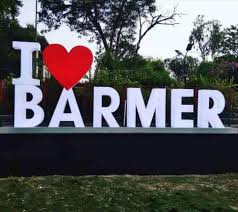Introduction
Barmer, located in the western part of Rajasthan, India, is a district that captivates with its rich culture, history, and unique desert landscapes. As a part of the Thar Desert, Barmer is known for its sand dunes, vibrant folk music, dance, and age-old traditions that continue to thrive in the modern era. This blog aims to provide a detailed, SEO-optimized overview of Barmer, covering everything from its history and culture to tourism, economy, and lifestyle.
History of Barmer
Barmer’s history is steeped in valor and tradition, reflecting the essence of Rajasthan. The district was originally known as Mallani, named after Rawal Mallinath, a Rajput ruler who is revered as a local deity. Barmer was founded by Bahada Rao (also known as Bar Rao), a Parmar ruler, in the 13th century, and the town was subsequently named after him.
Early Inhabitants
The area has been inhabited since the pre-historic period, as evidenced by the ancient rock carvings and inscriptions found in the region. Over the centuries, Barmer has seen the rise and fall of various dynasties, including the Chauhans, Paramaras, and the Delhi Sultanate. The region also played a significant role during the era of the Princely States.
Post-Independence Era
After India gained independence, Barmer became part of the state of Rajasthan. It has since developed into an important district, known for its natural resources and cultural heritage.
2. Geography and Climate
Barmer is part of the Thar Desert, and its landscape is characterized by sand dunes, thorny bushes, and sparse vegetation. The district covers an area of about 28,387 square kilometers, making it one of the largest districts in Rajasthan.
Climate
The climate of Barmer is arid, with extreme temperatures. Summers can be scorching, with temperatures often exceeding 45°C (113°F), while winters are mild, with temperatures ranging between 5°C to 23°C (41°F to 73°F). The monsoon season is brief, with sparse rainfall that barely meets the needs of agriculture.
Natural Resources
Barmer is rich in minerals like bentonite, fuller’s earth, and gypsum. The district is also known for its oil reserves, which have been a significant source of economic growth in recent years.
3. Cultural Heritage
Barmer is a treasure trove of Rajasthani culture, with a vibrant tradition of folk music, dance, and crafts.
Folk Music and Dance
The music of Barmer is deeply rooted in the desert landscape, with traditional instruments like the Kamaycha, Sindhi Sarangi, and Dholak playing a central role. The Langas and Manganiars, two famous musician communities, have kept the musical traditions alive. Dances like Ghoomar and Kalbelia are popular, especially during festivals.
Handicrafts and Art
Barmer is famous for its handicrafts, particularly wood carving, pottery, and embroidery. The intricate Barmer embroidery is known for its bright colors and mirror work, often seen on clothing, bags, and home decor items. The traditional ajrakh block printing is another craft that has put Barmer on the global map.
Festivals and Fairs
Festivals in Barmer are celebrated with much fervor. The Barmer Thar Festival, held annually, showcases the district’s rich cultural heritage through music, dance, camel races, and craft exhibitions. Other notable festivals include Diwali, Holi, and Teej.
4. Tourist Attractions
Barmer offers a unique blend of natural beauty and cultural experiences, making it a must-visit destination for those exploring Rajasthan.
Barmer Fort
Barmer Fort, built by Rawat Bhima in the 16th century, is a prominent historical site. Although in ruins, the fort offers a glimpse into the district’s glorious past and provides panoramic views of the surrounding landscape.
Kiradu Temples
Located about 35 kilometers from Barmer, the Kiradu Temples are a group of ancient temples dating back to the 11th century. These temples, known for their intricate carvings, are often referred to as the “Khajuraho of Rajasthan.”
Mahabar Sand Dunes
For those looking to experience the desert, the Mahabar Sand Dunes offer an ideal spot for camel rides and desert safaris. The dunes provide a stunning backdrop for photography, especially during sunrise and sunset.
Neemari
Neemari is a picturesque village near Barmer, known for its scenic beauty and traditional Rajasthani lifestyle. Visitors can experience rural tourism here, including staying in mud huts, enjoying local cuisine, and participating in folk music and dance performances.
Safed Akhara
A spiritual destination, Safed Akhara is a revered ashram in Barmer, attracting pilgrims from across the region. The ashram is known for its serene environment and religious significance.
5. Economy of Barmer
Barmer’s economy has traditionally been based on agriculture and handicrafts, but in recent years, it has seen significant growth due to its mineral and oil resources.
Agriculture
Despite the arid climate, agriculture remains a key part of Barmer’s economy. The main crops grown in the district include bajra (pearl millet), moong (green gram), and guar (cluster beans). Farmers here have adapted to the harsh desert conditions by practicing drought-resistant farming techniques.
Handicrafts Industry
The handicrafts sector here, is a major contributor to the local economy. The district’s artisans are known for their skills in embroidery, block printing, and wood carving, with products being exported to various parts of India and abroad.
Oil Industry
The discovery of oil in it has been a game-changer for the district’s economy. The Barmer oil fields, operated by Cairn India, are among the largest in the country, contributing significantly to both the local and national economy.
6. Lifestyle in Barmer
The lifestyle in it is a blend of traditional and modern influences, reflecting the district’s rich cultural heritage and evolving economy.
Traditional Lifestyle
The people of Barmer are known for their hospitality and strong adherence to traditional customs. Life in rural Barmer is still largely centered around agriculture and crafts, with joint families and community living being common.
Modern Developments
With the growth of the oil industry and improved infrastructure, it has seen an influx of modern amenities and services. Education and healthcare facilities have improved, and there has been a rise in employment opportunities, especially in urban areas.
Cuisine
The cuisine of Barmer is typical of Rajasthan, featuring dishes like dal bati churma, ker sangri, and bajre ki roti. The food is often spicy and is traditionally vegetarian, although non-vegetarian dishes are also popular.
7. Challenges and Opportunities
Like many other regions in Rajasthan, Barmer faces challenges related to its harsh climate and limited natural resources. However, there are also opportunities for growth, especially in sectors like tourism, handicrafts, and renewable energy.
Water Scarcity
Water scarcity is one of the most significant challenges facing Barmer. The district receives minimal rainfall, and groundwater resources are limited. Efforts are being made to address this issue through rainwater harvesting and other sustainable water management practices.
Infrastructure Development
While it has seen improvements in infrastructure, there is still room for growth, particularly in rural areas. The development of roads, electricity, and digital connectivity is crucial for the district’s continued economic development.
Renewable Energy Potential
It has significant potential for renewable energy development, particularly solar and wind energy. The vast desert landscape and abundant sunshine make it an ideal location for solar power projects, which could provide a sustainable source of energy for the district and beyond.
Conclusion
Barmer is a district that embodies the spirit of Rajasthan, with its rich cultural heritage, stunning desert landscapes, and resilient people. While it faces challenges like water scarcity and infrastructure development, the district also has immense potential for growth, particularly in the tourism, handicrafts, and renewable energy sectors. For those looking to explore the authentic Rajasthani experience, it offers a unique blend of history, culture, and natural beauty that is sure to leave a lasting impression.
Whether you are a traveler seeking new adventures, a history enthusiast, or someone interested in the economic development of Rajasthan, it has something to offer. Its story is one of tradition and transformation, making it a fascinating destination for anyone looking to experience the heart of the Thar Desert.
FAQs about Barmer
Q1: What is Barmer known for?
A: It is known for its rich cultural heritage, including folk music, dance, and handicrafts. It is also famous for its desert landscapes, historical sites like Barmer Fort and Kiradu Temples, and its oil reserves.
Q2: What are the main tourist attractions in Barmer?
A: The main tourist attractions in it include the Barmer Fort, Kiradu Temples, Mahabar Sand Dunes, Neemari, and Safed Akhara.
Q3: How is the climate in Barmer?
A: It has an arid climate, with extremely hot summers where temperatures can exceed 45°C, mild winters, and very little rainfall during the monsoon season.
Q4: What is the significance of Barmer in Rajasthan’s economy?
A: It plays a significant role in Rajasthan’s economy due to its oil reserves, agriculture, and handicrafts industry. Its oil fields are among the largest in India.
Q5: What are the traditional crafts of Barmer?
A: It is famous for its traditional crafts, particularly its embroidery, ajrakh block printing, and wood carving.
Q6: What is the best time to visit Barmer?
A: The best time to visit it is during the winter months (October to March) when the weather is cooler and more comfortable for sightseeing.
Q7: How can I reach Barmer?
A: It is well connected by road and rail. The nearest airport is in Jodhpur, about 200 kilometers away. Barmer Railway Station connects the district with major cities in Rajasthan and India.
Q8: Are there any festivals celebrated in Barmer?
A: Yes, it is known for its vibrant festivals, including the Barmer Thar Festival, which showcases the district’s cultural heritage through music, dance, and crafts.
Q9: What languages are spoken in Barmer?
A: The primary language spoken here is Rajasthani, but Hindi is also widely understood and spoken by the local population.
Q10: What are the economic opportunities in Barmer?
A: It offers economic opportunities in sectors such as oil extraction, agriculture, handicrafts, and tourism. There is also potential for growth in renewable energy, particularly solar and wind power.




